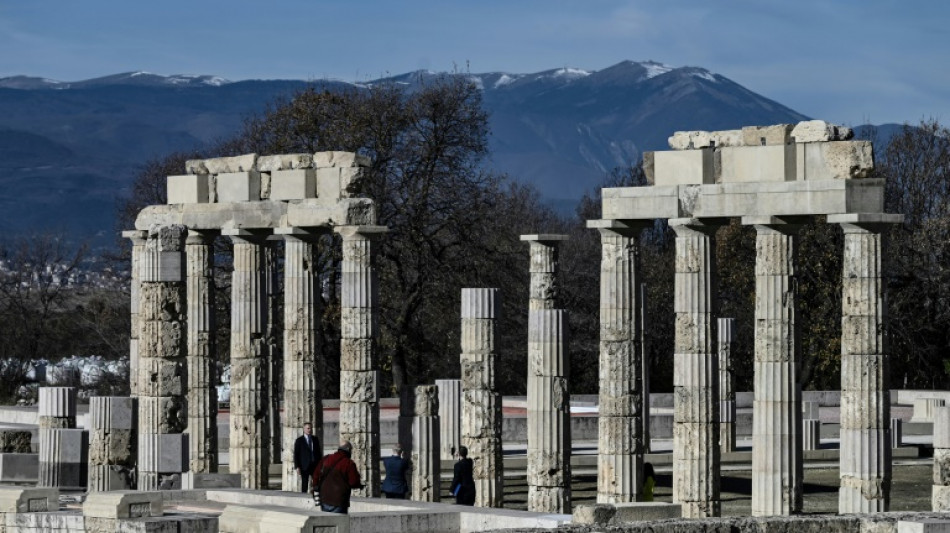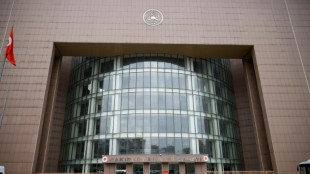
-
 Kane hoping to extend England career beyond 2026 World Cup
Kane hoping to extend England career beyond 2026 World Cup
-
Gazans rebuild homes from rubble in preparation for winter

-
 'Vague' net zero rules threaten climate targets, scientists warn
'Vague' net zero rules threaten climate targets, scientists warn
-
Stocks, dollar hesitant as traders eye US rate outlook, Nvidia

-
 G20 wrestles with wars, climate in run-up to Trump
G20 wrestles with wars, climate in run-up to Trump
-
'Agriculture is dying': French farmers protest EU-Mercosur deal

-
 Beyonce to headline halftime during NFL Christmas game
Beyonce to headline halftime during NFL Christmas game
-
Rescuers struggle to reach dozens missing after north Gaza strike

-
 Russia vetoes Sudan ceasefire resolution at UN
Russia vetoes Sudan ceasefire resolution at UN
-
G20 host Brazil launches alliance to end 'scourge' of hunger

-
 Stocks, dollar hesitant as traders scale back US rate cut bets
Stocks, dollar hesitant as traders scale back US rate cut bets
-
Trump confirms plan to use military for mass deportation

-
 Schools closed in Beirut after deadly Israeli air raid
Schools closed in Beirut after deadly Israeli air raid
-
Anger, pain in Turkey as 'newborn deaths gang' trial opens

-
 Kremlin says Biden 'fuelling' war as Russian strikes rock Odesa
Kremlin says Biden 'fuelling' war as Russian strikes rock Odesa
-
UN climate chief at deadlocked COP29: 'Cut the theatrics'

-
 G20 leaders gather to discuss wars, climate, Trump comeback
G20 leaders gather to discuss wars, climate, Trump comeback
-
Stocks, dollar mixed as traders scale back US rate cut bets

-
 Stoinis lets rip as Australia crush Pakistan for T20 series whitewash
Stoinis lets rip as Australia crush Pakistan for T20 series whitewash
-
Bentancur banned for seven games over alleged racial slur

-
 Kremlin says Biden 'fuelling' tensions with Kyiv missile decision
Kremlin says Biden 'fuelling' tensions with Kyiv missile decision
-
COP host Azerbaijan jailed activists over 'critical opinions': rights body

-
 Composer of Piaf's 'Non, je ne regrette rien' dies aged 95
Composer of Piaf's 'Non, je ne regrette rien' dies aged 95
-
South African trio nominated for World Rugby player of year

-
 'Not here for retiring': Nadal insists focus on Davis Cup
'Not here for retiring': Nadal insists focus on Davis Cup
-
Tractor-driving French farmers protest EU-Mercosur deal

-
 Floods hit northern Philippines after typhoon forces dam release
Floods hit northern Philippines after typhoon forces dam release
-
Pakistan skittled for 117 in final T20 against Australia

-
 Schools closed in Beirut after deadly Israeli strike
Schools closed in Beirut after deadly Israeli strike
-
Chris Wood hits hat-trick in NZ World Cup qualifying rout

-
 Markets mixed after Wall St losses as traders weigh US rates outlook
Markets mixed after Wall St losses as traders weigh US rates outlook
-
US, Philippines sign deal on sharing military information

-
 Bangladeshi ex-ministers face 'massacre' charges in court
Bangladeshi ex-ministers face 'massacre' charges in court
-
Law and disorder as Thai police station comes under monkey attack

-
 Disgraced Singapore oil tycoon sentenced to nearly 18 years for fraud
Disgraced Singapore oil tycoon sentenced to nearly 18 years for fraud
-
Philippines cleans up as typhoon death toll rises

-
 Quincy Jones awarded posthumous Oscar
Quincy Jones awarded posthumous Oscar
-
'Critically endangered' African penguins just want peace and food

-
 Long delayed Ukrainian survival video game sequel set for release amid war
Long delayed Ukrainian survival video game sequel set for release amid war
-
Star Australian broadcaster charged with sex offences

-
 Philippines cleans up after sixth major storm in weeks
Philippines cleans up after sixth major storm in weeks
-
Woman-owned cafe in Indonesia's Sharia stronghold shakes stigma

-
 Indigenous Australian lawmaker who heckled King Charles censured
Indigenous Australian lawmaker who heckled King Charles censured
-
End of an era as Nadal aims for winning Davis Cup farewell

-
 Trump taps big tech critic Carr to lead US communications agency
Trump taps big tech critic Carr to lead US communications agency
-
Mitchell-less Cavs rip Hornets as perfect NBA start hits 15-0

-
 Markets swing after Wall St losses as traders weigh US rates outlook
Markets swing after Wall St losses as traders weigh US rates outlook
-
India's capital shuts schools because of smog

-
 Rio under high security for G20 summit
Rio under high security for G20 summit
-
G20 leaders to grapple with climate, taxes, Trump comeback


Greece revives 2,300 year-old palace where Alexander The Great was crowned
An ancient palace where Alexander The Great was crowned King of Macedonia will reopen to the public on Sunday after a 16-year 20 million euro renovation aiming to restore its past glory.
At a ceremony on Friday, Greek Prime Minister Kyriakos Mitsotakis called the Palace of Aigai a "monument of global importance."
The 4th century BC site spreads over 15,000 square meters was one of the most important in classical Greece alongside the Parthenon in Athens.
Aigai was capital of the Macedonian kingdom, the dominant military power of the time, and archeologists say the palace was the kingdom's spiritual centre.
Built by Philip II, the father of Alexander the Great, the tombs of Philip and other Macedonian kings are nearby.
After the assassination of his father, Alexander was crowned at the palace in 336 BC before launching a military campaign that created an empire stretching into modern-day India.
The palace "has a cultural and national character, because it confirms the Greek identity of Macedonia throughout the centuries," Mitsotakis said.
The site includes the royal palace and a colonnade that surrounded the palace and the agora, where ancient Macedonians debated important matters.
It was in the courtyard, with an 8,000 capacity, that Alexander was proclaimed king.
The Romans destroyed the palace in 148 BC. Excavations to uncover the site started in 1865 and continued into the 20th century.
The restoration project began in 2007 with help from the European Union.
Situated near the modern day Greek village of Vergina, the palace and the nearby tombs are listed as a World Heritage Site by UNESCO.
Greece has boosted investment in its many antique sites which have become an important source of tourist revenue.
For the past three decades, it has been demanding the return of sculptures taken from the Parthenon that are in the British Museum, saying they were looted in the 19th century when Greece was under Ottoman rule.
W.Morales--AT


